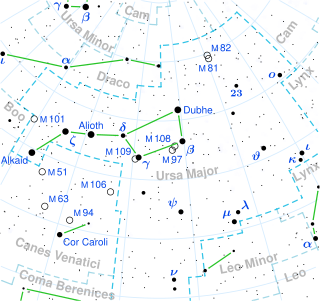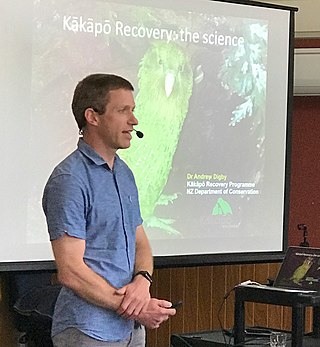Related Research Articles

Alcor is a binary star system in the constellation of Ursa Major. It is the fainter companion of Mizar, the two stars forming a naked eye double in the handle of the Big Dipper asterism in Ursa Major. The two both lie about 83 light-years away from the Sun, as measured by the Hipparcos astrometry satellite.

Mizar and Alcor are two stars forming a naked eye double in the handle of the Big Dipper asterism in the constellation of Ursa Major. Mizar consists of two stars with magnitudes 2.2 and 3.9 that can be seen easily without the aid of a telescope. Mizar's star is not a double star, but a four-star binary system located in the constellation Ursa Major. This system consists of two pairs of double stars that are gravitationally bound to each other. Mizar is the second star from the end of the Big Dipper's handle, and Alcor its fainter companion. The traditional name Mizar derives from the Arabic المئزر miʼzar meaning 'apron; wrapper, covering, cover'. Alcor was originally Arabic سها Suhā/Sohā, meaning either the ‘forgotten’ or ‘neglected’ one; notable as a faintly perceptible companion of Mizar. Mizar, also designated Zeta Ursae Majoris, is itself a quadruple system and Alcor, also designated 80 Ursae Majoris, is a binary, the pair together forming a sextuple system. In fact, it was the first known binary star system, discovered by Italian astronomer Giovanni Battista Riccioli in 1650. The whole system lies about 83 light-years away from the Sun, as measured by the Hipparcos astrometry satellite.

Mu Herculis is a nearby quadruple star system about 27.1 light years from Earth in the constellation Hercules. Its main star, Mu Herculis A is fairly similar to the Sun although more highly evolved with a stellar classification of G5 IV. Since 1943, the spectrum of this star has served as one of the stable anchor points by which other stars are classified. Its mass is about 1.1 times that of the Sun, and it is beginning to expand to become a giant.
Rebecca Oppenheimer is an American astrophysicist and one of four curator/professors in the Department of Astrophysics at the American Museum of Natural History (AMNH) on Manhattan's Upper West Side. Oppenheimer is a comparative exoplanetary scientist. She investigates planets orbiting stars other than the Sun. Her optics laboratory is the birthplace of a number of new astronomical instruments designed to tackle the problem of directly seeing and taking spectra of nearby solar systems with exoplanets and studying their composition, with the ultimate goal of finding life outside the solar system.
WASP-11/HAT-P-10 is a binary star. It is a primary main-sequence orange dwarf star. Secondary is M-dwarf with a projected separation of 42 AU. The system is located about 424 light-years away in the constellation Aries.
WASP-12 is a magnitude 11 yellow dwarf star located approximately 1347 light-years away in the constellation Auriga. WASP-12 has a mass and radius similar to the Sun and is known for being orbited by a planet that is extremely hot and has a retrograde orbit around WASP-12. WASP-12 forms a triple star system with two red dwarf companions. Both of them have spectral types of M3V and are only 38% and 37% as massive as the Sun, respectively.

HR 8799 is a roughly 30 million-year-old main-sequence star located 133.3 light-years away from Earth in the constellation of Pegasus. It has roughly 1.5 times the Sun's mass and 4.9 times its luminosity. It is part of a system that also contains a debris disk and at least four massive planets. Those planets, along with Fomalhaut b, were the first exoplanets whose orbital motion was confirmed by direct imaging. The star is a Gamma Doradus variable: its luminosity changes because of non-radial pulsations of its surface. The star is also classified as a Lambda Boötis star, which means its surface layers are depleted in iron peak elements. It is the only known star which is simultaneously a Gamma Doradus variable, a Lambda Boötis type, and a Vega-like star.

HR 8799 b is an extrasolar planet located approximately 129 light-years away in the constellation of Pegasus, orbiting the 6th magnitude Lambda Boötis star HR 8799. It has a mass between 4 and 7 Jupiter masses and a radius from 10 to 30% larger than Jupiter's. It orbits at 68 AU from HR 8799 with an unknown eccentricity and a period of 460 years, and is the outermost known planet in the HR 8799 system. Along with two other planets orbiting HR 8799, the planet was discovered on November 13, 2008 by Marois et al., using the Keck and Gemini observatories in Hawaii. These planets were discovered using the direct imaging technique.

HR 8799 c is an extrasolar planet located approximately 129 light-years away in the constellation of Pegasus, orbiting the 6th magnitude Lambda Boötis star HR 8799. This planet has a mass between 5 and 10 Jupiter masses and a radius from 20 to 30% larger than Jupiter's. It orbits at 38 AU from HR 8799 with an unknown eccentricity and a period of 190 years; it is the 2nd planet discovered in the HR 8799 system. Along with two other planets orbiting HR 8799, this planet was discovered on November 13, 2008, by Marois et al., using the Keck and the Gemini observatories in Hawaii. These planets were discovered using the direct imaging technique. In January 2010, HR 8799 c became the 3rd exoplanet to have a portion of its spectrum directly observed, confirming the feasibility of direct spectrographic studies of exoplanets.

HR 8799 e is a large exoplanet, orbiting the star HR 8799, which lies 129 light-years from Earth. This gas giant is between 5 and 10 times the mass of Jupiter. Due to their young age and high temperature all four discovered planets in the HR 8799 system are large, compared to all gas giants in the Solar System.
HAT-P-27, also known as WASP-40, is the primary of a binary star system about 659 light-years away. It is a G-type main-sequence star. The star's age is similar to the Sun's at 4.4 billion years. HAT-P-27 is enriched in heavy elements, having a 195% concentration of iron compared to the Sun.

Spectro-Polarimetric High-contrast Exoplanet REsearch (VLT-SPHERE) is an adaptive optics system and coronagraphic facility at the Very Large Telescope (VLT). It provides direct imaging as well as spectroscopic and polarimetric characterization of exoplanet systems. The instrument operates in the visible and near infrared, achieving exquisite image quality and contrast over a small field of view around bright targets.
Phi Fornacis is a single star in the southern constellation of Fornax. It has a white hue and is faintly visible to the naked eye with an apparent visual magnitude of 5.13. The distance to this object is approximately 154 light-years based on parallax, and it is drifting further away with a radial velocity of +19 km/s.

K2-33 is an extremely young pre-main-sequence star located about 453 light-years (139 pc) away from the Earth in the constellation of Scorpius. It is known to host one planet, a super-Neptune, named K2-33b. It is also notable for its young age.

Andrew Digby is an astronomer and ecologist whose work focusses on researching and conserving New Zealand's endangered endemic birds.
HAT-P-18 is a K-type main-sequence star about 530 light-years away. The star is very old and has a concentration of heavy elements similar to solar abundance. A survey in 2015 detected very strong starspot activity on HAT-P-18.
HAT-P-15 is a G-type main-sequence star about 630 light-years away. The star is older than Sun yet has a concentration of heavy elements roughly 190% of solar abundance. The star has no noticeable starspot activity.
HAT-P-28 is the primary of a binary star system about 1320 light-years away. It is a G-type main-sequence star. The star's age is older than the Sun's at 6.1+2.6
−1.9 billion years. HAT-P-28 is slightly enriched in heavy elements, having a 130% concentration of iron compared to the Sun. Since 2014, the binary star system is suspected to be surrounded by a debris disk with a 6.1″(2500 AU) radius.
References
- 1 2 3 4 Crepp, Justin R.; Pueyo, Laurent; Brenner, Douglas; Oppenheimer, Ben R.; Zimmerman, Neil; Hinkley, Sasha; Parry, Ian; King, David; Vasisht, Gautam; Beichman, Charles; Hillenbrand, Lynne; Dekany, Richard; Shao, Mike; Burruss, Rick; Roberts, Lewis C. (2011-02-18). "Speckle Suppression with the Project 1640 Integral Field Spectrograph". The Astrophysical Journal. 729 (2): 132. arXiv: 1012.4016 . Bibcode:2011ApJ...729..132C. doi:10.1088/0004-637x/729/2/132. ISSN 0004-637X. S2CID 35264912.
- 1 2 "Project 1640 Conducts First Remote Reconnaissance of Another Solar System". American Museum of Natural History. March 10, 2013. Retrieved April 1, 2013.
- ↑ Hinkley, Sasha; Oppenheimer, Ben R.; Zimmerman, Neil; Brenner, Douglas; Parry, Ian R.; Crepp, Justin R.; Vasisht, Gautam; Ligon, Edgar; King, David; Soummer, Remi; Sivaramakrishnan, Anand; Beichman, Charles; Shao, Michael; Roberts, Jr; Bouchez, Antonin (2011). "A New High Contrast Imaging Program at Palomar Observatory". Publications of the Astronomical Society of the Pacific. 123 (899): 74–86. arXiv: 1012.0008 . Bibcode:2011PASP..123...74H. doi:10.1086/658163. S2CID 6053630.
- 1 2 3 Oppenheimer, B. R.; Baranec, C.; Beichman, C.; Brenner, D.; Burruss, R.; Cady, E.; Crepp, J. R.; Dekany, R.; Fergus, R.; Hale, D.; Hillenbrand, L.; Hinkley, S.; Hogg, David W.; King, D.; Ligon, E. R. (2013-04-10). "Reconnaissance of the Hr 8799 Exosolar System. I. Near-Infrared Spectroscopy". The Astrophysical Journal. 768 (1): 24. arXiv: 1303.2627 . Bibcode:2013ApJ...768...24O. doi:10.1088/0004-637X/768/1/24. ISSN 0004-637X. S2CID 7173368.

